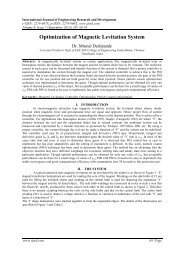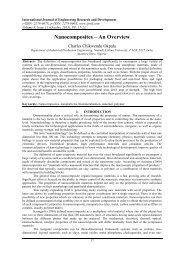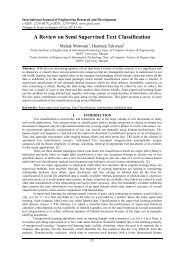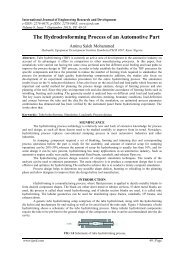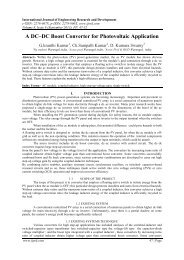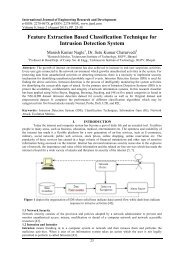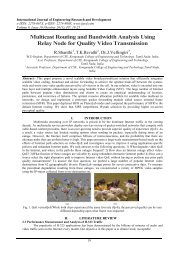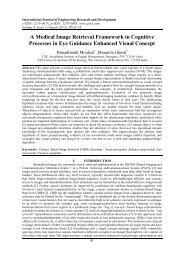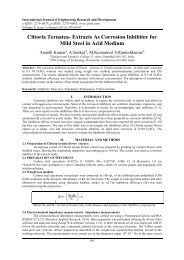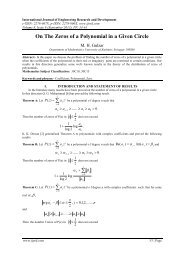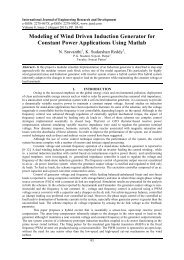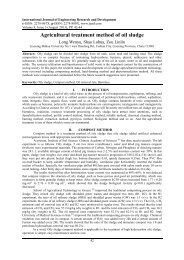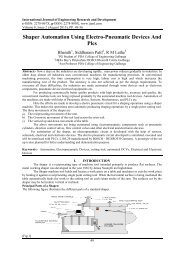J08096267.pdf
Create successful ePaper yourself
Turn your PDF publications into a flip-book with our unique Google optimized e-Paper software.
International Journal of Engineering Research and Development<br />
e-ISSN: 2278-067X, p-ISSN: 2278-800X, www.ijerd.com<br />
Volume 8, Issue 9 (September 2013), PP. 62-67<br />
Study Effect of Pads shapes on Temperature Distribution for Disc<br />
Brake Contact Surface<br />
Saeed Abu Alyazeed Albatlan<br />
Higher Technological Institute, 10th of Ramadan City, 6th October Branch. Cairo, Egypt<br />
ABSTRACT<br />
This study describes an inertial dynamometer system (test rig) which has been applied to the testing of disc<br />
brake pads at different operating conditions. The test rig is equipped with several measuring instruments, and<br />
data acquisition systems [DAQ], which are necessary for performing the tests. Two sets of brake pads are tested.<br />
This study explains the temperature distribution obtained by experiments on two different shapes of brake discs<br />
pads affected by the types of shapes of brake discs pads, disc geometry and operating conditions. The test results<br />
also showed that the friction with hatched pad better fade resistance than the others.<br />
Keywords: - disc brake; thermal stress; hatched pads; temperature distribution.<br />
I. INTRODUCTION<br />
During the operation of the brake system, kinetic energy is converted into thermal energy through<br />
friction between the brake pad and rotor faces. Excessive thermal loading can result in surface cracking, judder<br />
and high wear of the rubbing surfaces. High temperatures can also lead to overheating of the brake fluid, seals<br />
and other components. Initially the generated thermal energy is transferred by conduction to the components in<br />
contact and next by convection and radiation to environment (Fig.1) as explained in [1, 2, 3]. Brakes absorb the<br />
kinetic energy of moving masses by help of friction forces. The dynamic of braking process depends on friction<br />
pair materials, loading and temperature, as well as impact of environment [4]. Limpert [5] compared the solid<br />
and ventilated rotor thermal performance and concluded that the total convective heat transfer coefficient<br />
consisted of approximately one-third cooling from the vanes, and two-thirds from the friction surfaces exposed<br />
to the ambient air. Temperature distribution and comparison of simulation results and experimental results in the<br />
disc by 2D thermal analysis using axisymmetricmodel is presented in[6]. In [7] showed through experiment that<br />
the brake torque variation depends on several factors such as the temperature, the number of revolutions and the<br />
disc depends on several factors such as the temperature, thickness variation. The analytical modeling and<br />
dynamic characteristics of disc brake systems under equal contact loads on both sides of the disc can be found in<br />
[8]. New mathematical equations for heat generation between disc brake and pads include on parameters such<br />
as the duration of braking, vehicle velocity, geometries and the dimensions of the brake components, materials<br />
of the disk brake rotor and the pad and contact pressure distribution are shown in [9]. The factors affecting the<br />
interface temperature, including the number of braking applications, sliding speed, braking load and type of<br />
friction material are presented in [10]. Thermal analysis of a brake system requires frictional energy dissipation<br />
as a heat input. Frictional heat dissipation can be easily determined under the dynamometer laboratory<br />
conditions where the brake torque and the rotational speed of the brake disk are know. For vehicle braking the<br />
frictional heat dissipation should be determined from the given vehicle and brake system parameters [11]. In [12]<br />
determined the transient temperature distributions in a disc brake during a single brake application using Finite<br />
difference numerical technique. Hyperbolic heat conduction which includes the effect of the finite heat<br />
propagation is gaining importance.<br />
This paper aims to study and compare the temperature distributions caused by mutual sliding of two<br />
members of the disc brake pads, and describes an inertial dynamometer system which has been applied to the<br />
testing of disc brake assembly at different operating conditions.<br />
62
Study Effect of Pads shapes on Temperature Distribution for Disc Brake Contact Surface<br />
Fig. 1: Heat dissipation inside and outside the discs due to conduction, convection and radiation [3]<br />
II. THEORETICAL ANALYSIS<br />
2.1 Determination of Kinetic Friction Coefficient<br />
It is essential to determine coefficient of friction that is generated between the disc and the pad contact<br />
interface. It has been known that coefficient of friction would be changed under different braking operating<br />
conditions such as brake-line pressure, disc speed, temperature and other factors.<br />
Braking torque can be calculated as follows:<br />
T F friction reff<br />
(1)<br />
Where Ffriction is the friction force generated at the contact interface and reff is the effective pad radius.<br />
However friction force is dependent upon normal force (Fnormal) and friction coefficient (μ), which is derived as<br />
below:<br />
F friction Fnormal<br />
(2)<br />
Normal force (Fnormal) can be determined based on brake-line pressure (p) applied onto top of the piston,<br />
which is given in the following equation:<br />
Fnormal pApiston<br />
(3)<br />
Now by substituting equation (3) into equations (2) and then (1), braking torque can be calculated as follows:<br />
T pApiston<br />
reff<br />
(4)<br />
For a disc brake system there is a pair of brake pads, thus the total brake torque is:<br />
T 2pApiston<br />
reff<br />
(5)<br />
Since the braking torque output (T) can be obtained experimentally, and the cross sectional area of the<br />
piston in contact with the braking fluid (Apiston), brake-line pressure (p) and pad effective radius (reff) are all<br />
known parameters, then coefficient of friction can be calculated. Thus equation (5) now becomes:<br />
T<br />
<br />
2 pApistonr<br />
eff<br />
(6)<br />
2.2 Brake disc thermal stresses<br />
The brake disc and the pads are exposed to high thermal stresses due to high quantity of energy<br />
transformed from mechanical to thermal. Thermal stress is defined by the thermal strain generated by<br />
temperature variation inside an object and due to exterior condition of having no possibility to contract or<br />
expand [3]. Those stresses can be written as [3]:<br />
E<br />
(<br />
)<br />
1<br />
v<br />
(7)<br />
Where <br />
- brake disc thermal expansion coefficient,<br />
a , T- local disc temperature (real),<br />
Ta – environment temperature, E – Young's modulus, v- Poisson coefficient. The values of depends on<br />
temperature, but in most cases is considered constant. From relation (7), it the dependence of thermal stress with<br />
temperature and coefficient can be observed.<br />
63
Study Effect of Pads shapes on Temperature Distribution for Disc Brake Contact Surface<br />
III. EXPERIMENTAL WORK<br />
The experimental work will be presented in three main sections. The first section contains the<br />
description of the test rig. The second section the measurement instruments followed used in different tests and<br />
data acquisition components [DAQ]. The third section comprises the different tests conducted on brake pads.<br />
The details of each section is given below.<br />
3.1 Test Rig<br />
The test rig was designed and constructed to allows testing different types of pads and rotors at<br />
different operation conditions. Fig. 2 shows a general layout of the test rig. The test rig consists of engine; spark<br />
ignition, four stroke, and 4-cylinders in line 1. The engine equipped with clutch, manual gear box 2, flexible<br />
joint 3, and drive shaft supported with four bearing on frame to drive flywheel and disc brake as shown in Fig. 3.<br />
The rig uses actual brake system units and components to simulate the vehicle brake system. Brake pedal<br />
equipped with electric motor and control unit to control pedal travel.<br />
3.2 Measuring Instruments<br />
The test rig is equipped with several measuring instruments, which are necessary for performing the<br />
tests. The measuring instruments are shown in Fig. 4 include, pressure transducer, displacement sensor (position<br />
sensor), speed sensors and non-contact infrared thermometer. All the transducer and sensors are interfaced with<br />
a connector block through shielded cables. The connector block is connected to a DAQ board, (connect with<br />
computer by USB cable) that collects the data during experimental test runs.<br />
3.3 Experiments<br />
The experimental research was carried out in the laboratory on disc brake dynamometer Fig. 3, in<br />
a short time repeating braking regime. Two different shapes of pads were tested on disc brake dynamometer. Fig<br />
5 shows two types of pads.<br />
During the experiment the disc brake surface temperature, brake pressure, rotor velocity and braking time were<br />
measured.<br />
1- Engine 2- Manual gearbox 3- Flexible joint 4-Bearing 5-Flywheel<br />
6-Coupling 7-Vented disc 8- Caliper 9-Spring 10- Brake master<br />
11-Brake servo 12- Brake pedal 13- Brake pedal motor<br />
14- Brake pedal motor control 15- RPM sensor 16-Displacement sensor<br />
17-Pressure sensor 18-DCsupply 19- DAQ board<br />
20- CPU<br />
Fig. 2: Layout of test rig<br />
64
Study Effect of Pads shapes on Temperature Distribution for Disc Brake Contact Surface<br />
1- Engine 2- Manual gearbox 3- Flexible joint 4-Bearing 5-Flywheel<br />
6-Coupling 7-Vented disc 8- Caliper 9-Spring 10- Brake master<br />
11-Brake servo 12- Brake pedal<br />
Fig. 3: Test rig components<br />
13- Brake pedal motor 14- Brake pedal motor control 15- RPM sensor<br />
16-Displacement sensor 17-Pressure sensor 19- DAQ board 20- CPU<br />
Fig. 4: Test rig measuring facilities<br />
(a) Flat pad used in test (b) hatched pad used in test<br />
Fig. 5: Shape of pads tested<br />
fig. 6: Location of disc brake surface temperature measured<br />
IV. RESULTS AND DISCUSSION<br />
The evolutions of the temperature distribution on a disc brake contact surface during braking for<br />
experimental as shown in Figs7 to 11 for both cases under different operating condition.<br />
4.1 Effect of brake pedal travel<br />
Figures from 7 to 8 show the experimental results of the relation between the disc speeds against the<br />
measured temperature distribution on a disc brake contact surface in two cases.<br />
Case I: Flat pads used in test<br />
Case II: hatched pads used in test<br />
65
Study Effect of Pads shapes on Temperature Distribution for Disc Brake Contact Surface<br />
Fig. 7 represents the temperature distribution on a disc brake contact surface in two cases of pads at<br />
slow rate of pedal travel. Fig. 8 shows the effect of fast rate (sudden) of pedal travel.<br />
The detailed analysis of the results revealed that the temperature distribution on a disc brake is greatly affected<br />
by the type of brake pad shape, especially when using hatched pad. The temperature increases with the<br />
beginning of the process of braking when Flat pad used in test.<br />
The brake disc and the pads are exposed to high thermal stresses due to high quantity of energy transformed<br />
from mechanical to thermal.<br />
Thermal stress is defined by the thermal strain generated by temperature variation inside an<br />
object and due to exterior condition of having no possibility to contract or expand [3].<br />
Braking performance of a vehicle can be significantly affected by the temperature rise in the brake components.<br />
High temperatures during braking may cause brake fade, premature wear, and brake fluid vaporization, bearing<br />
failure, thermal cracks and thermally-excited vibration. Therefore, it is important to predict the temperature rise<br />
of a given brake system and assess its thermal performance in the early design stage.<br />
The coefficient of friction would be changed under different braking operating conditions such as brake-line<br />
pressure, disc speed, temperature and other factors<br />
The coefficient of friction of the brake friction material will drop after prolonged use of the brakes. This is<br />
commonly known as brake fade [13].<br />
Temperature (Celcius)<br />
250<br />
200<br />
150<br />
100<br />
50<br />
Temperature at t1 case(I)<br />
Temperature at t2 case(I)<br />
Temperature at t3 case(I)<br />
Temperature at t1 case(II)<br />
Temperature at t2 case(II)<br />
Temperature at t3 case(II)<br />
0<br />
10 15 20 25<br />
Speed (km/h)<br />
30 35 40<br />
Fig. 7: Temperature Distribution at Slow Rate of Brake Pedal Travel on Disc Brake [Case I & Case II)<br />
Temperature (Celcius)<br />
100<br />
90<br />
80<br />
70<br />
60<br />
50<br />
40<br />
30<br />
20<br />
10<br />
Temperature at t1 case(I)<br />
Temperature at t2 case(1)<br />
Temperature at t3 case(I)<br />
Temperature at t1 case(II)<br />
Temperature at te case(II)<br />
Temperature at t3 case(II)<br />
0<br />
10 15 20 25<br />
Speed (km/h)<br />
30 35 40<br />
Fig. 8: Temperature distributions at slow rate of brake pedal travel on disc brake [case (I) & case (II)]<br />
4.2 Effects of brake-line pressure and disc speed (operating conditions)<br />
Figure 9 compares directly between the temperatures distributions on a disc brake contact surface at<br />
brake line pressure 15, 30 bar and speed 10, 20, 30, 40 km/h, when hatched pad used in test. As indicated in this<br />
figure changed according operating conditions such as brake-line pressure, disc speed.<br />
66
Study Effect of Pads shapes on Temperature Distribution for Disc Brake Contact Surface<br />
Temperature (Celcius)<br />
100<br />
90<br />
80<br />
70<br />
60<br />
50<br />
40<br />
30<br />
20<br />
10<br />
Temperature at t1, pressure=15 bar<br />
Temperature at t2, pressure=15 bar<br />
data3<br />
Temperature at t1, pressure=30 bar<br />
Temperature at t2, pressure=30 bar<br />
Temperature at t3, pressure=30 bar<br />
0<br />
10 15 20 25<br />
Speed (km/h)<br />
30 35 40<br />
Fig. 9: Temperature distributions at brake pressure 15, 30 bar on disc brake [case (II)]<br />
Figures 7 to 9 show disc temperature surface variations along radial direction obtained with<br />
experimental results. The change of temperature depends on disc geometry [14].<br />
V. CONCULATION<br />
1-The analysis of the laboratory results indicated that the temperature distribution on a disc brake is greatly<br />
affected by the type of brake pads shapes.<br />
2- The temperature generated depending on the operating conditions, rate of pedal brake travel and disc<br />
geometry.<br />
3- The test results also showed that the friction with hatched pad better fade resistance than the others<br />
REFERENCES<br />
[1]. Z. Chi, G. F. Naterer and Y. He, Thermal Performance Analysis of Vented Automotive Brake Discs,<br />
CSME Forum 2008, University of Ottawa, Ottawa, Canada, 2008.<br />
[2]. A., M., Amin, S., M., Seri, V., R., Raghavan, Study Of The Temperature Distribution In Disc Brakes<br />
By The Method Of Order-Of-Magnitude Analysis, Regional Conference on Engineering Mathematics,<br />
Mechanics, Manufacturing & Architecture (EM3ARC) 2007.<br />
[3]. Voldaca and Gheorghe, "Concerns Regarding Temperature Distribution Obtained by Experiments and<br />
Finite Element Analyses for Two Types of Brake Discs" U.P.B Bull., Series D, Vol. 74, Iss. 3, 2012.<br />
[4]. Feldmanis et al, "Mathematical Modeling of Disc Brake Friction Lining Heat and Wear", Jelgava, 29.-<br />
30.05.2008.<br />
[5]. Limpert, R., "Cooling Analysis of Disc Brake Rotors," SAE Technical Paper 751014, 1975. 668 842,<br />
Sept. 16, 1997.<br />
[6]. Kumar, R., "Transient Thermoelastic Analysis of Disk Brake Using Ansys Software", M. Sc. Thesis,<br />
Mechanical Engineering Department, Thapar University, June, 2008.<br />
[7]. Kang, J., & Choi, S., "Brake dynamometer model predicting brake torque variation due to disc<br />
thickness variation", Proc. IMechE Vol. 221 Part D: J. Automobile Engineering, IMechE, 2007.<br />
[8]. Pilipchuk, V. N.," Disc Brake Ring-Element Modeling Involving Friction-Induced Vibration "Journal<br />
of Vibration and Control, Vol. 8, No. 8, 1085-1104, 2002.<br />
[9]. Jalalifar Salman et al, "Analysis of heat conduction in a disk brake system" Journal of Heat and Mass<br />
Transfer, Vol. 45, No. 8, January, 2009.<br />
[10]. Day A.J., et al, "Investigation of disc/pad interface temperatures in friction braking", J. Wear, Vol 262,<br />
PPs (505-513), February, 2007.<br />
[11]. Kwangjin Lee, "Numerical Prediction of Brake Fluid Temperature Rise During Braking and Heat<br />
Soaking", SAE, Technical Papers Series, 1999-01-0483.<br />
[12]. K.Venkateswara Reddy & Rama Murthy," Temperature Profiles in a Disc Brake "Applications and<br />
Applied Mathematics Journal, Vol. 5, No. 1, pp. 239-254. June, 2010.<br />
[13]. Jang, H., et al," The Effect of Metal on The Friction Performance of Automotive Brake Friction<br />
Materials" (ELSEVIER) Wear 256, pp. 406-414, 2004.<br />
[14]. Murali Mohan Rao, et al, "Experimental and Simulated Studies on Temperature Distribution for<br />
Various Disc Brakes" IJRMET Vol. 3, Issue 1, Nov-April, 2013.<br />
67




